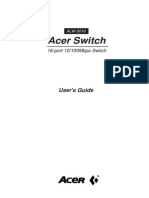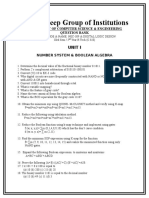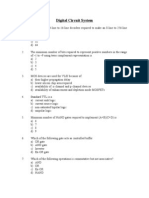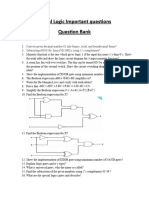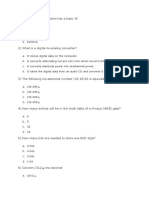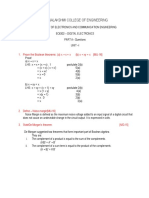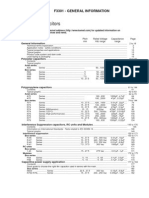CO Assignment#1
Uploaded by
kawthar AlmousaCO Assignment#1
Uploaded by
kawthar AlmousaCOMPUER ORGANIZATION (CE-313)
Assignment #1
QUESTION NO. 1: ENCIRCLE THE CORRECT ANSWER:
(i) According to the DeMorgan’s Law, (x+y)’ = _________________
(a) x’y’ (b) (xy)’ (c) x’+y’ (d) All of the these
(ii) The output of 2-input EX-OR gate is always zero when both inputs are ___________________
(a) One is 1 and other is 0 (b) Different (c) Similar (d) None of these
(iii) A ________________ circuit is connected arrangement of logic gates with a set of inputs and outputs.
(a) Binary (b) Sequential (c) Logical (d) Combinational
(iv) A combinational circuit that performs the arithmetic addition of two bits is called ________________
(a) Binary Adder (b) Full Adder (c) Half Adder (d) Digital Adder
(v) ________________ is a binary cell capable of storing one bit of information.
(a) Flip-flop (b) Binary sequencer (c) Toggle device (d) Memory
(vi) The operations executed on data stored in registers are called _____________________
(a) Logical operations (b) Nano operations (c) Binary operations (d) Micro operations
(vii) The examples of micro-operations are __________________
(a) Delete, Clear, Download (b) Save, Delete, Drop (c) Save, browse, kill (d) Shift, Clear, Load
(viii) The register transfer (x + y) : R2 R1 means ________________
a) If x and y are both 1 then contents of R1 are transferred to R2
b) If x = 1 or y = 1 or both are 1 then contents of R1 are transferred to R2
c) If x = 1 or y = 1 or both are 1 then contents of R2 are transferred to R1
d) None of the above
(ix) Rather than connecting wires between all registers a ___________________ is used.
(a) Zigzag Path (b) Common Diode (c) Common bus (d) Wireless connection
(x) The three-state gate is a digital circuit that exhibits three states, two of the states are signals
equivalent to logic 1 and 0, the third state is a _____________________
(a) low voltage state (b) is high current state (c) high-impedance state (d) None of these
QUESTION NO. 2:
Combinational Circuits, Flip flops, Sequential Circuits.
1. Design the circuits for the following:
(i) Having a digital system that has 2 Registers (A and B) each of 2 bit size. Implement the Bus
Circuit that Selects any ONE of them to be provided as an input to any other circuit.
(ii) Having a digital system that has 3 Registers (A, B and C) each of 3 bit size. Implement the Bus
Circuit that Selects any TWO of them to be provided as an input to any other circuit.
(iii) Having the following two micro-operations:
a. X : R3 R2 + R1
b. X' : R3 R3 – 1
Implement the logic circuit that can perform the two micro-operations, and select only one of
them at a time. Registers are of size 2 bits.
(iv) Having the following two micro-operations:
a. X : R3 R2 – R1
b. X' : R3 R3 + 1
Implement the logic circuit that can perform the two micro-operations, and select only one of
them at a time. Registers are of size 2 bits.
QUESTION NO. 3
Register Transfer and Microoperations
1. The Adder-Subtractor circuit of Figure 4-7 has the following values for input mode M and the data
inputs A and B. In each case determine the values of outputs: S3, S2, S1, S0 and C4
S# M A B
a. 0 0111 0110
b. 0 1000 1001
c. 1 1100 1000
d. 1 0101 1010
e. 1 0000 0001
2. The following transfer statements specify a memory. Explain operation in each case.
a. R2 M[AR]
b. M[AR] R3
c. R5 M[R5]
***************
You might also like
- Simple Free-Energy Devices: Chapter 23: Power From InertiaNo ratings yetSimple Free-Energy Devices: Chapter 23: Power From Inertia3 pages
- Acustica - Calendar - 2022 + Eminence ManualNo ratings yetAcustica - Calendar - 2022 + Eminence Manual15 pages
- Compuer Organization (Ce-313) Assignment #1No ratings yetCompuer Organization (Ce-313) Assignment #13 pages
- Compuer Organization (Ce-313) Assignment #1 (SOLUTION)No ratings yetCompuer Organization (Ce-313) Assignment #1 (SOLUTION)6 pages
- Mca 101 Computer Organization and Architecture 2011No ratings yetMca 101 Computer Organization and Architecture 20114 pages
- Ugc Net Merit Entrance Sectional Test No.00No ratings yetUgc Net Merit Entrance Sectional Test No.008 pages
- 106A - Computer Organization and Architecture100% (1)106A - Computer Organization and Architecture43 pages
- Mca 101 Computer Organisation and Architecture 2011No ratings yetMca 101 Computer Organisation and Architecture 20114 pages
- Top 100 MCQs on Logic Design and Computer OrganizationNo ratings yetTop 100 MCQs on Logic Design and Computer Organization14 pages
- Coa Module 2 Previous Year Question Paper SolvedNo ratings yetCoa Module 2 Previous Year Question Paper Solved25 pages
- Dhanalakshmi College of Engineering: 1. Prove The Boolean Theorems: (A) X + X X (B) X + Xy X (M/J-16)No ratings yetDhanalakshmi College of Engineering: 1. Prove The Boolean Theorems: (A) X + X X (B) X + Xy X (M/J-16)18 pages
- 1 Digital Circuit BIHAR STATE EXAM BY ADDA 2024 (2)No ratings yet1 Digital Circuit BIHAR STATE EXAM BY ADDA 2024 (2)24 pages
- Unit 2 Register Transfer & Microoperations_1No ratings yetUnit 2 Register Transfer & Microoperations_152 pages
- Solution To Assignments For BScCSIT 3rd Semester (2069)No ratings yetSolution To Assignments For BScCSIT 3rd Semester (2069)8 pages
- Th-3 Digital Electronics and MicroprocessorNo ratings yetTh-3 Digital Electronics and Microprocessor9 pages
- Smart Arduino Projects: 10 Hands-On Builds with Shift Registers and Multiplexers for Automation and IoTFrom EverandSmart Arduino Projects: 10 Hands-On Builds with Shift Registers and Multiplexers for Automation and IoTNo ratings yet
- Whitepaper Ground Potential Rise ExplainedNo ratings yetWhitepaper Ground Potential Rise Explained17 pages
- The Polarity of Voltage Drop Along The Current Direction Is To Be Marked As PositiveNo ratings yetThe Polarity of Voltage Drop Along The Current Direction Is To Be Marked As Positive5 pages
- Aljotronic Control 2: Technical Reference ManualNo ratings yetAljotronic Control 2: Technical Reference Manual30 pages
- Transformer Protection RET650: Product GuideNo ratings yetTransformer Protection RET650: Product Guide80 pages
- Elements of Digital Communication SystemNo ratings yetElements of Digital Communication System72 pages
- (TDB) VRF DVM S Eco For America (R410a, 60hz, HP) Ver.1.0No ratings yet(TDB) VRF DVM S Eco For America (R410a, 60hz, HP) Ver.1.055 pages
- A Limited-Preview Filtered B-Spline Approach To Tracking Control - With Application To Vibration-Induced Error Compensation of A 3D PrinterNo ratings yetA Limited-Preview Filtered B-Spline Approach To Tracking Control - With Application To Vibration-Induced Error Compensation of A 3D Printer11 pages
- Grounding and Bonding - Temporary Power Generation and Electrical Distribution100% (2)Grounding and Bonding - Temporary Power Generation and Electrical Distribution22 pages
- High Isolated Four Element MIMO Antenna For ISM LTE 5G Sub-6GHz ApplicationsNo ratings yetHigh Isolated Four Element MIMO Antenna For ISM LTE 5G Sub-6GHz Applications14 pages
- MT6169 - MT6158 - R2008 CT - Phase-2 - Ref - SCH - V1.1No ratings yetMT6169 - MT6158 - R2008 CT - Phase-2 - Ref - SCH - V1.18 pages
- Addressable-22051TE-–-Photoelectric-Thermal-Multi-Criteria (1)No ratings yetAddressable-22051TE-–-Photoelectric-Thermal-Multi-Criteria (1)2 pages

